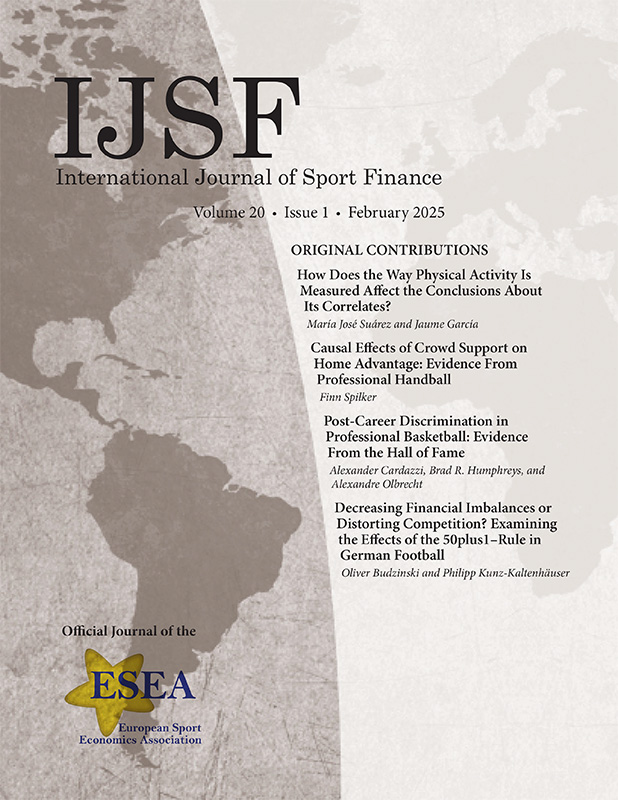
Articles
How Does the Way Physical Activity Is Measured Affect the Conclusions About Its Correlates?
Abstract
The definition of physical activity in the literature on sports practice is highly heterogeneous. This article provides evidence of the extent to which the inclusion of walking, which is one of the most frequent types of physical activity, and the minimum frequency used to consider a person a practitioner affect the conclusions about the correlates of physical activity practice and frequency. To this end, we compared participation and frequency models by applying different measures of physical activity. We found that the activities included under the definition of physical activity play a relevant role in terms of the effects of the covariates in both the participation and frequency models. However, the minimum frequency used to define a person as a practitioner is not associated with significant changes in the effects of the correlates. These conclusions may have relevant policy implications in terms of designing measures to promote participation in physical activity.
DOI: doi.org/10.32731/IJSF/201.022025.01
Causal Effects of Crowd Support on Home Advantage: Evidence from Professional Handball
Abstract
This study examines home advantage in German handball, focusing on the impact of varying attendance due to COVID-19. Like in other sports, home advantage is acknowledged in handball, but the audience’s impact on it remained unexplored. Analyzing data from 3,235 matches of the first and second German handball Bundesliga, we find a statistical home advantage consistent with prior research. During the pandemic, we identify a significant decrease in home advantage without spectators in the first division, while the second division remains unaffected. This applies to both the winning probability and the points achieved by the home teams. Additionally, we demonstrate a pre-pandemic referee bias; however, it only contributed to the existing home advantage to a small extent. Accordingly, spectators appear to be able to influence handball referees, but to a much smaller extent than in other sports.
DOI: doi.org/10.32731/IJSF/201.022025.02
Post-Career Discrimination in Professional Basketball: Evidence from the Hall of Fame
Abstract
Economic research on racial discrimination frequently employs data from sports. We analyze admission decisions for the Naismith Basketball Hall of Fame (HOF) for evidence of discrimination against Black National Basketball Association (NBA) players from the 1950s to the 2010s. Our results suggest that, holding career performance constant, the average Black former All-Star, who is not currently in the HOF, is about five percentage points less likely to be admitted into the HOF compared to similar non-Black All-Stars. This represents about a 50% reduction in the probability of admission into the HOF. The anonymous electors to the HOF appear to act on discriminatory preferences. Like the results in the NBA salary discrimination literature, this effect disappeared in the 1980s and 1990s and reappeared in the 2000s.
DOI: doi.org/10.32731/IJSF/201.022025.03
JEL Codes: J7, Z21, Z22
Decreasing Financial Imbalances or Distorting Competition? Examining the Effects of the 50plus1-Rule in German Football
Abstract
The 50plus1-rule in German football is a controversially discussed institutional change that regulates investment behavior of professional football teams. This paper provides an empirical analysis of its effects. We gathered panel data on 47 teams in the German Major League Football (“Erste Bundesliga”) from the seasons 1989/90 until 2018/19.
This paper applies a difference-in-difference approach to examine investment behavior in budgets as well as sporting success between impacted competitors and those exempted from the rule. Our results do not suggest any equalizing properties of the regulation. By contrast, we find anticompetitive effects and distorting properties of the regulation.
DOI: doi.org/10.32731/IJSF/201.022025.04
JEL Codes: Z23, Z21, Z2, J83, L11, L50

